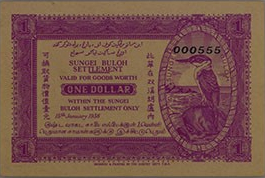
PREV ARTICLE
NEXT ARTICLE
FULL ISSUE
PREV FULL ISSUE
LEPER COLONY CURRENCYThis article on the PMG site discusses the coins and paper money of Leper colonies. Here's an excerpt - see the complete article online. -Editor 
1 Dollar issue from the Sungei Buloh Settlement Money can do a lot of things, but immunity to an infectious disease is one thing money can't buy. However, if you already have an illness (for example, leprosy), money can help in many ways. It can be used to buy treatment as well as everyday necessities like food and housing. In cases of infectious disease, where there is fear of transmission, having currency that flows between the infected and uninfected can heighten the risk of transference. One solution to this problem is to issue new currency within the quarantined community. For this month's article, we will be discussing paper money used in certain leper colonies. Leprosy, also known as Hansen's disease, is an infectious disease that can damage the skin, eyes, respiratory tract and nervous system. Leprosy has affected humans for thousands of years and was once (and still is, in certain parts of the world) considered much more deadly and contagious than it really is. The fear of leprosy eventually led to those who suffered from it being ostracized from their homes and placed in quarantined communities, also called leper colonies. Scholars today believe that people sent to leper colonies were affected by a broad spectrum of skin conditions. In other words, what was often called leprosy would today be classified as a wide range of different afflictions. Leper colonies, or leprosoriums, became prevalent during the Middle Ages, especially in Europe and India. They were often administered by monastic orders and sometimes located on islands or up in mountains to make them more remote. In more recent times, in order to further quarantine these communities and prevent spreading the disease, some colonies would issue their own currency. The first issues of leper colony currency came in the form of coins. The oldest known leprosorium coins were minted in Colombia in 1901. In other parts of the world, paper money was issued either alongside or instead of coins. For instance, scrip notes were issued in 1935 and 1936 at the Sungei Buloh Settlement in modern-day Malaysia. Like company scrip, the notes issued at Sungei Buloh could be used exclusively for goods and services offered within the settlement or by approved vendors. The notes were issued by the Survey Department of the Federated Malay States. A 5 Cent denomination was first issued in 1935. A second issue was put in circulation the following year that consisted of a 5 Cent, a 10 Cent and a 1 Dollar denomination. Another leprosorium that issued paper money was on the island of Culion in the Philippines. The Culion Leper Colony was founded in 1902. Initially, special coins were issued, authorized by the Philippine government in 1913. Then, in 1942, the Japanese invasion cut off Culion from Manila, where the coins were minted, and created a lack of currency. In order to buy supplies and pay salaries, an emergency issue of paper money was approved by the president-in-exile, Manuel Quezon. The notes were further backed by the United States Army administration. The Culion paper money was issued in seven denominations: 1, 5, 20 and 50 Centavos, as well as 1, 5 and 20 Pesos. To read the complete article, see:
 Wayne Homren, Editor The Numismatic Bibliomania Society is a non-profit organization promoting numismatic literature. See our web site at coinbooks.org. To submit items for publication in The E-Sylum, write to the Editor at this address: whomren@gmail.com To subscribe go to: https://my.binhost.com/lists/listinfo/esylum All Rights Reserved. NBS Home Page Contact the NBS webmaster 
|